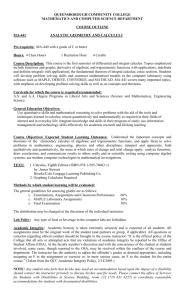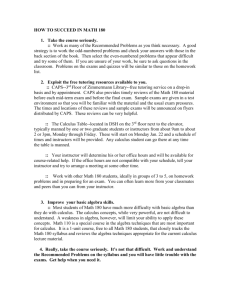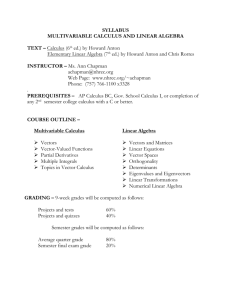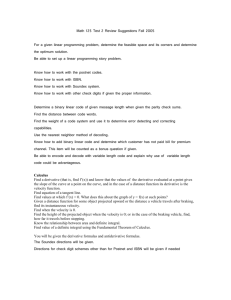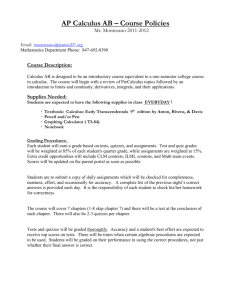Doug Girvan - Red Deer College
advertisement
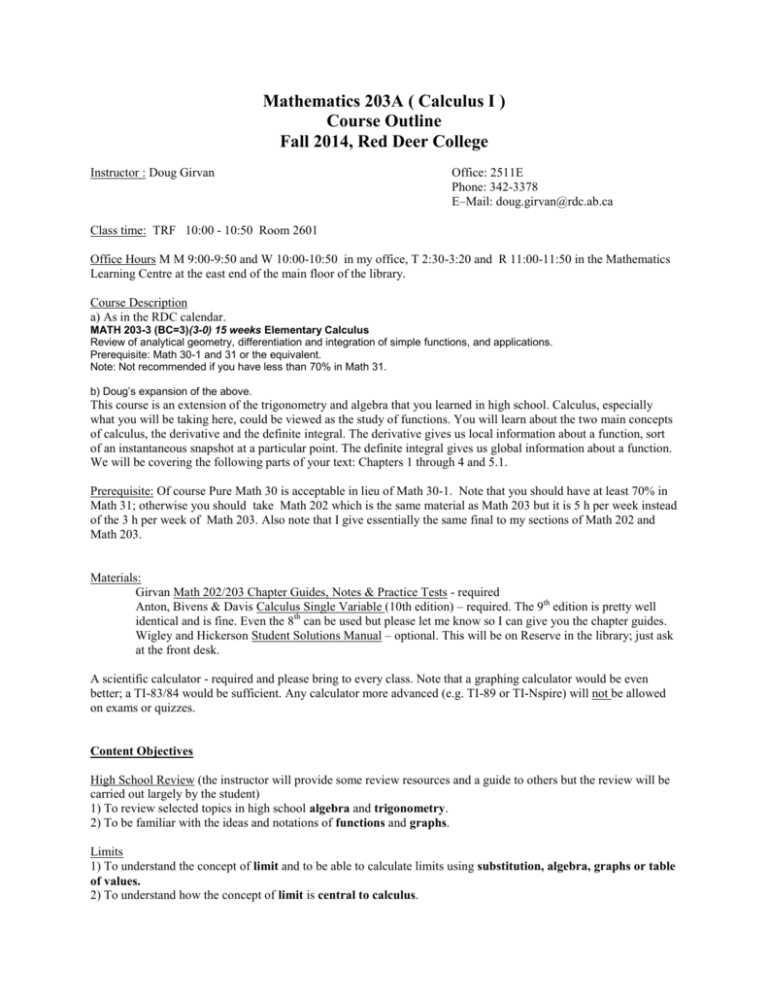
Mathematics 203A ( Calculus I ) Course Outline Fall 2014, Red Deer College Instructor : Doug Girvan Office: 2511E Phone: 342-3378 E–Mail: doug.girvan@rdc.ab.ca Class time: TRF 10:00 - 10:50 Room 2601 Office Hours M M 9:00-9:50 and W 10:00-10:50 in my office, T 2:30-3:20 and R 11:00-11:50 in the Mathematics Learning Centre at the east end of the main floor of the library. Course Description a) As in the RDC calendar. MATH 203-3 (BC=3)(3-0) 15 weeks Elementary Calculus Review of analytical geometry, differentiation and integration of simple functions, and applications. Prerequisite: Math 30-1 and 31 or the equivalent. Note: Not recommended if you have less than 70% in Math 31. b) Doug’s expansion of the above. This course is an extension of the trigonometry and algebra that you learned in high school. Calculus, especially what you will be taking here, could be viewed as the study of functions. You will learn about the two main concepts of calculus, the derivative and the definite integral. The derivative gives us local information about a function, sort of an instantaneous snapshot at a particular point. The definite integral gives us global information about a function. We will be covering the following parts of your text: Chapters 1 through 4 and 5.1. Prerequisite: Of course Pure Math 30 is acceptable in lieu of Math 30-1. Note that you should have at least 70% in Math 31; otherwise you should take Math 202 which is the same material as Math 203 but it is 5 h per week instead of the 3 h per week of Math 203. Also note that I give essentially the same final to my sections of Math 202 and Math 203. Materials: Girvan Math 202/203 Chapter Guides, Notes & Practice Tests - required Anton, Bivens & Davis Calculus Single Variable (10th edition) – required. The 9th edition is pretty well identical and is fine. Even the 8th can be used but please let me know so I can give you the chapter guides. Wigley and Hickerson Student Solutions Manual – optional. This will be on Reserve in the library; just ask at the front desk. A scientific calculator - required and please bring to every class. Note that a graphing calculator would be even better; a TI-83/84 would be sufficient. Any calculator more advanced (e.g. TI-89 or TI-Nspire) will not be allowed on exams or quizzes. Content Objectives High School Review (the instructor will provide some review resources and a guide to others but the review will be carried out largely by the student) 1) To review selected topics in high school algebra and trigonometry. 2) To be familiar with the ideas and notations of functions and graphs. Limits 1) To understand the concept of limit and to be able to calculate limits using substitution, algebra, graphs or table of values. 2) To understand how the concept of limit is central to calculus. The Derivative: Theory and Applications 1) To understand the concept of derivative and be able to calculate it using the limit definition, formulas, graphs or table of values. 2) To be able to calculate the derivatives of sums, differences, products, quotients and compositions of algebraic and trigonometric functions. 3) To understand and be able to use the following applications of the derivative: implicit differentiation and related rates. 4) To understand the relationship of the first and second derivative to the graph of a function and how knowledge of these derivatives helps to ascertain certain key features of the graph of the function. 5) To be able to use the derivative to help solve the class of problems known as max-min problems. 6) To learn the application of the derivative to economics (marginal analysis). 7) (if time allows) To know Rolle's Theorem and the Mean Value Theorem and be able to explain them graphically. The Definite and Indefinite Integral: Theory and Application 1) To understand the concept of anti-derivative and be able to apply it to some pracrical situations. 2) To understand the idea and notation of the definite integral and how the area problem relates to this concept. 3) To know and to be able to explain the Fundamental Theorems of Calculus. 4) To be able to calculate indefinite and definite integrals using algebraic simplification and/or u-substitution. 5) To be able to calculate the area between curves using the definite integral. The Relationship amongst the following classes of functions: continuous, differentiable and integrable (if time) The student should also note the following process objectives for the whole course. 1) The Rule of Three - i.e. being able to explain the main concepts of the course and to solve problems using algebra, graphs or numerical techniques. 2) To be able to work in a group situation to solve problems and to help each other understand the course. 3) To be able to use technological aids such as graphic calculators and a Computer Algebra System (CAS) such as Derive to extend one's problem solving abilities while at the same time realizing the limitations of these devices. 4) To be able to check the reasonableness of answers and to be able to explain how one's solution was arrived at. Coverage: Essentially we will cover Chapters 1-4 and 5.1. For each chapter I have a section in my Manual detailing what can be safely omitted and suggesting odd-numbered practice questions from that chapter. Note that my Manual also contains an outline of the lectures. Evaluation: Assignments* (about 18 to 20) Test 1 – to end of section 2.3 (about Oct. 9) Test 2 – to end of Chapter 2 (about Oct. 24) Test 3 – Chapter 3 (about Nov. 18) Final Exam - from chapter 2 on Total 10 12 16 12 50 100 * - Assignments average out to about two a (non-test) week. They will be given out on Blackboard or handed out in class at least two days ahead of when they are due. This semester I’m going to record the raw score for each Assignment. Last year the total raw score was 325 marks. The weighting on individual assignments ranged from 10 marks to 36 marks. I expect it will be similar this semester. a) Students will be consulted as to any changes in the evaluation or to any other part of the course outline; any changes will also have to be approved by the Chairperson of Science. b) The only legitimate reason for missing an assignment, quiz or exam is a valid certificate from a doctor. Even in such cases the student should notify the instructor as soon as possible. c) At the end of the course students will be ranked according to their percentage mark, calculated by a) above, in the course. Then the instructor will assign the letter grades in the Grading Policy on the College web site, using his experience and judgment and the principle that students who receive approximately the same percentage mark should receive the same letter grade. d) Feedback as to your progress in the course will be given by the date indicated in the calendar. e) Directions on assignments may be given out separately but the most important thing on tests and assignments is that you be able to explain how you arrived at your answer. f) Since you have three hours to write the final exam (and lots of time to study for it!) you can expect that it will contain some harder questions than the term tests throughout the year. Assistance: a) Me - my office hours are at the beginning of this outline. If you are unable to meet me then, please make an appointment or drop around and take your chances. Because calculus is such a cumulative subject it is imperative that you seek assistance as soon as a problem arises. When you come for help, please bring your work on the problem you're having trouble with. You can also phone me during my office hours; however, don’t E-Mail me with math content questions as math notation isn’t that easy in E-Mail. b) Besides me (see above) there will be three other main forms of assisstance i) Peter Bovell will be the Math Tutor and can assist you with University Transfer Math . Information about Peter’s location(s) and hours will be forthcoming. ii) Peer tutors should be available. Here’s the procedure to contact a Peer tutor: Students who would like assistance from a peer tutor can go to the Learning Support desk in the Library (it is located to the side of the main Information desk) and fill out a peer tutor request form with their contact information then drop it off in the box provided. We send an email requesting course information. This also helps us ensure we have the right email address. When we hear back from the student we then make the match with a peer tutor (so long as we have one available) and the peer tutor makes contact with the student to arrange a time to meet. iii) The Math Learning Centre will be at the east end of the main floor of the library. I will have a couple of my office hours in there (see the start of this course outline) and there may be other University Transfer math instructors with other hours there. c) Library - other calculus books are in the QA303 section of the library while those dealing with high school math are in the QA145 - QA154 section. d) Your text. One source suggests the following sequence when using a math text. - read the text; however, a math text is not like a novel and it should be read with pen and paper handy.First try to understand the main structure of the section i.e. the definitions and theorems. - study the examples, first trying to work them out without looking at the solution. - begin the suggested homework problems. e) Each other. Find one or more people to do homework and/or study with. You will find that when one student tries to explain something to another that both gain; this is why I may allow you to do some of your assignments in groups. Attendance Requirements: Students will be expected to attend every class, Otherwise they are responsible for obtaining the notes, announcements etc. from another student. After they have obtained and studied these notes the instructor will be very willing to assist them with that material. Solutions to the Assignments will be put on Blackboard after the assignments are marked. Note that since I provide full solutions to the assignments I may not make many written comments while correcting your assignment. A Personal Note to the Student Math 31 should give you excellent background for Math 203. However, don’t let “familiarity breed contempt”! Only a good sustained effort will give you an acceptable grade. If your high school calculus teacher used different language or notation please don’t hesitate to tell me. You may have a chance to formally evaluate the course. Generic Statements & Information Required to be on All Course Outlines It is the student’s responsibility to be familiar with the information contained in the Course Outline and to clarify any areas of concern with the instructor. Students should refer to the Formal and Informal Student Appeal Policies and Standard Practice should they have questions or concerns about the Course Outline that cannot be resolved with the instructor. Please be familiar with what constitutes academic misconduct, as well as the consequences. Plagiarism involves submitting work in a course as if it were the student’s own work. Plagiarism may involve the act of submitting work in which some or all of the phrasing, ideas, or line of reasoning are alleged to be the submitter’s own but in fact were created by someone else. The Final Examinations Policy will be followed with respect to final exams. Please review these documents to ensure you understand the contents and implications of the policy. Attendance may take many forms. Lack of attendance may impact the students’ ability to successfully complete the course. This course may be eligible for Prior Learning Assessment. Students should refer to the RDC College Calendar for a list of excluded courses. Classroom Learning Resources may be available to students in alternate formats. Students should be aware that Personal Counseling, Career, Learning and Disability Services are provided by RDC. Inquire about locations at Information Desk. It is the student’s responsibility to discuss their specific learning needs with the appropriate service provider. Important dates for the 2014 Fall Term at RDC (from college website June 4, 2014) (see the previous pages of this course outline for other dates that are specific to this course) 03 Sep First Day of Classes 05 Sep Last Day to apply for Fall 2014 10 Sep Last day to have tuition refunded for Fall Term 2014 courses 11 Sep Last day to register for Fall Term 2014 courses 01 Oct First day to apply for Fall term 2015 07 Oct Emergency Response Day 13 Oct Thanksgiving Day. College closed. 24 Oct Mid-term feedback date 10 Nov Final examination schedule posted 10 Nov College Open. No credit classes 11 Nov Remembrance Day. College Closed 03 Dec Last day to withdraw from Fall Term 2014 courses and receive a WD on transcript 03 Dec 08 Dec 13 Dec 16 Dec 19 Dec 22 Dec 22 Dec 24 Dec 02 Jan 05 Jan 07 Jan 09 Jan 12 Jan 12 Jan 17 Jan Last day of classes for Fall Term courses First day of final examinations for Fall Term 2014 courses Last day of final examinations for Fall Term 2014 courses Deferred exams written for Fall Term 2014 courses Last day for submission of final grades for Fall Term 2014 courses Final grades for Fall Term 2014 courses available Last day of course waitlist for Winter Term 2015 College closes at noon College Opens. No credit classes First day of classes for Winter Term 2015 Last day to apply for Winter term 2015 Last day to apply/pay fees for Winter Term 2015 Last Day to apply for supplemental exam for Fall Term 2014 courses Last day to have tuition refunded for Winter Term 2015 courses. Supplemental Exams for Fall Term courses written Changes to the course outline will be made with the consent of the course instructor and students. Changes will be reviewed by the Department Chairperson for consistency with College policies. Program Lead:___________________________________ 27 August 2014 Date:___________________________________



